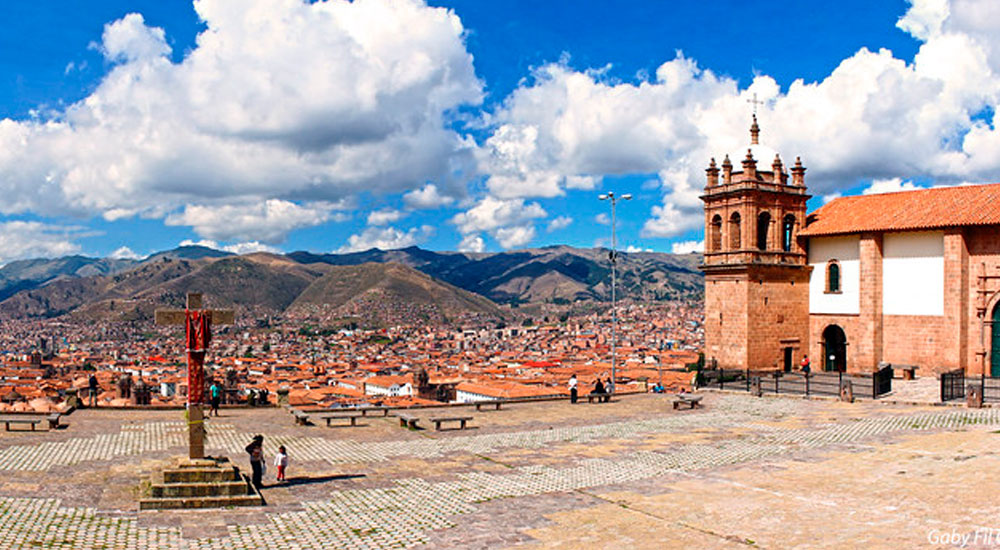Nestled in the heart of Cusco, the ancient capital of the Inca Empire, is a breathtaking vantage point that offers visitors a unique and unforgettable perspective of this historic city. The Mirador de San Cristobal, also known as the San Cristobal Viewpoint, is a must-visit destination for anyone exploring Cusco. In this comprehensive guide, we’ll unravel the wonders of this site, from its remarkable history to its stunning views, and why it’s a jewel in the crown of Cusco’s cultural heritage.
Discovering San Cristobal viewpoint
The San Cristobal viewpoint is a place of cultural and historical significance in Cusco. Located atop the hill that shares its name, this viewpoint offers a panoramic view of the city’s historic center, which is a UNESCO World Heritage site. The name “San Cristobal” is derived from Saint Christopher, who is the patron saint of Cusco’s oldest parish church, Iglesia San Cristobal. This proximity to the church further emphasizes the viewpoint’s cultural importance.

However, what truly makes the San Cristobal viewpoint exceptional is the unparalleled vista it provides. From this vantage point, you’ll be treated to a sweeping perspective of Cusco’s historic heart. As you gaze out, you’ll see the city’s iconic terracotta roofs, winding cobblestone streets, and prominent landmarks, all set against the backdrop of the majestic Andes. This view is like stepping into a living postcard of Cusco’s rich history and vibrant culture.
Every visit to the San Cristobal viewpoint is a journey through time, where the past and present seamlessly merge. The viewpoint serves as a living testimony to Cusco’s enduring legacy, showcasing the unique blend of Inca and Spanish influences that shape the city. Whether you’re an artist seeking inspiration, a historian delving into the city’s layers, or a traveler simply in search of breathtaking beauty, the San Cristobal viewpoint delivers an experience that resonates with the soul and etches Cusco’s enchantment into your memory.
Stepping Back in Time: A Historical Context
Before we delve into the panoramic vistas of the San Cristobal viewpoint, let’s take a moment to appreciate the historical context of Cusco and this viewpoint.

Cusco, which means “navel of the world” in the Quechua language, was the capital of the Inca Empire. Today, it retains much of its historical charm with its colonial architecture built atop Inca foundations.
The San Cristobal viewpoint isn’t just an observation point; it’s a testament to the blending of indigenous Inca and Spanish colonial influences. The viewpoint is home to a stone monument, an intricately carved sculpture that pays homage to the merging of these two cultures.
The Mirador’s Unforgettable Views
Now, let’s shift our gaze to the highlight of the San Cristobal viewpoint: the spectacular views. The viewpoint sits at an elevation of approximately 3,500 meters (11,500 feet) above sea level, making it an excellent spot to admire Cusco’s cityscape and the surrounding Andean mountains.
To the north, you’ll have an unobstructed view of Cusco’s central square, the Plaza de Armas, with the grand Cathedral of Cusco and the Church of La Compañía as prominent landmarks. This perspective showcases the city’s architectural beauty, with terracotta roofs and historic facades forming a picturesque scene.

To the south, your view extends to the rolling hills and picturesque landscapes that frame the city. On clear days, you might even catch glimpses of the sacred mountains of the Incas, including Ausangate, Salkantay, and Pachatusan. The unspoiled natural beauty that surrounds Cusco is a reminder of the region’s profound connection to the earth and the cosmos.
At night, the San Cristobal viewpoint takes on a different charm. The city’s lights create a stunning display against the dark backdrop of the Andean night sky. It’s a time when the city’s vibrant nightlife comes to life, with warm glows from restaurants, bars, and traditional celebrations.
Cultural Significance: The Meeting of Cultures
Cusco is a city where the past and present coexist harmoniously. It’s a place where indigenous traditions meet Spanish colonial influences. The San Cristobal viewpoint is a symbol of this rich cultural fusion.

At the viewpoint, you’ll find the “Tawantinsuyo” monument, a testament to the Inca’s deep respect for their surroundings and the merging of cultural identities. The Tawantinsuyo represents the Inca concept of a unified empire, where the four suyos (regions) converged at the capital, Cusco.
As you explore this monument, you’ll find intricate carvings and motifs, including the condor, puma, and serpent, which were sacred animals in Inca cosmology. The presence of these symbols, coupled with the Spanish colonial architecture visible from the viewpoint, serves as a reminder of the city’s complex history and the amalgamation of two worlds.
Visiting Mirador de San Cristobal
Accessing the San Cristobal viewpoint is relatively easy and offers a unique opportunity to explore more of Cusco. You can reach the viewpoint in a few ways:
On Foot: The viewpoint is located within walking distance of Cusco’s Plaza de Armas. A leisurely uphill stroll allows you to take in the city’s vibrant atmosphere as you ascend to the Mirador.
By Taxi: Taxis are a convenient way to reach the viewpoint, especially if you’re short on time or prefer a more direct route. Taxis are readily available in Cusco and can drop you off at the Mirador’s entrance.
As Part of a Tour: Many city tours and guided excursions include a visit to the San Cristobal viewpoint, providing valuable insights into its cultural and historical significance.
The viewpoint is typically open during daylight hours, and visiting is free of charge. The experience is especially enchanting during the early morning hours when the city is bathed in soft sunlight, and in the evening when Cusco’s lights illuminate the night.
Cultural Exploration and Souvenirs
Exploring the artisan markets near the San Cristobal viewpoint is an integral part of the experience, adding a vibrant cultural dimension to your visit. These markets are like a treasure trove of Andean craftsmanship, where you’ll encounter the skilled hands and creative spirits of local artisans.
One of the highlights of these markets is the dazzling array of textiles. Peruvian textiles are celebrated worldwide for their intricate designs, vivid colors, and superb quality. You’ll find beautifully woven textiles such as alpaca wool scarves, ponchos, and blankets. These textiles often feature traditional motifs that tell stories of Inca legends, Andean landscapes, and ancient symbols, adding an extra layer of cultural richness to your souvenir.

Pottery is another craftsmanship you’ll discover in these markets. Ceramics have been an essential part of Andean culture for centuries. Handcrafted pottery pieces come in various forms, from delicate figurines to functional cookware. You can appreciate the craftsmanship involved in creating these unique pieces, each one bearing the mark of the artisan’s personal touch.
If you’re seeking unique adornments and accessories, the markets are a haven for jewelry enthusiasts. Silverwork is particularly prevalent, with intricate filigree designs, semi-precious stones, and symbols inspired by Andean cosmology. Pieces such as earrings, necklaces, and bracelets make for special keepsakes or gifts.
Traditional Andean garments are another highlight. These include beautifully crafted ponchos, chullos (knit hats), and intricately designed belts, all of which showcase the expertise of local weavers and textile artists. Wearing these garments not only adds a touch of Andean authenticity to your wardrobe but also connects you to the region’s rich textile heritage.
Exploring these markets isn’t just a shopping experience; it’s an immersion into the soul of the Andes. The artisans you’ll meet often share their knowledge and passion for their crafts. You can witness demonstrations of weaving techniques, pottery-making, and jewelry design, gaining a deeper appreciation for the artistry behind these creations.
It’s important to remember that when you purchase from these artisans, you’re directly supporting their livelihoods and contributing to the preservation of these time-honored traditions. So, while you’re acquiring unique souvenirs, you’re also playing a role in the cultural conservation of this region. This adds a profound layer of significance to your visit to the Mirador de San Cristobal and the neighboring markets, making it not just a shopping excursion but a cultural exchange that fosters a deeper connection to the heart of Cusco.
Preservation and Conservation
Cusco, a city that pulsates with history, is deeply committed to preserving its cultural and architectural heritage. This dedication encompasses not only its renowned landmarks but also extends to hidden gems like the Mirador de San Cristobal. Perched atop a hill and offering a panoramic view of the city, this viewpoint plays an essential role in Cusco’s historical and cultural narrative.
The conservation of the San Cristobal viewpoint is part of the broader strategy to safeguard the city’s identity and rich heritage. Efforts are in place to maintain the viewpoint’s accessibility and ensure it remains a focal point for locals and visitors alike. This commitment reflects the collective desire to share the enchantment of Cusco from this distinctive vantage point with future generations.

The conservation initiatives encompass various aspects, including the preservation of the surrounding flora, the maintenance of the viewpoint’s infrastructure, and ongoing archaeological studies. These efforts not only protect the physical structures but also aim to unravel the historical layers that make this location so remarkable.
As you stand at the San Cristobal viewpoint, taking in the breathtaking view of Cusco’s red-tiled roofs and ancient streets, you’re not merely gazing upon a picturesque landscape. You’re witnessing a city that respects its past and, with an eye to the future, works diligently to ensure that the legacy of Cusco endures.

In your visit to the San Cristobal viewpoint, you’re not only a spectator; you’re a participant in the preservation of history. Your appreciation of this viewpoint contributes to the ongoing efforts that keep Cusco’s cultural heart beating. It’s a testament to the city’s dedication to sharing its enchantment and legacy, ensuring that generations to come can experience the magic of Cusco from this unique vantage point, just as you have.
The San Cristobal viewpoint offers an exceptional view of Cusco’s captivating past and present. It’s a place where history and culture converge, providing visitors with a profound connection to the heart of the Inca Empire and the soul of modern-day Cusco. A visit to this remarkable viewpoint is a journey into the heart of a city that continues to honor its heritage while embracing the future.








